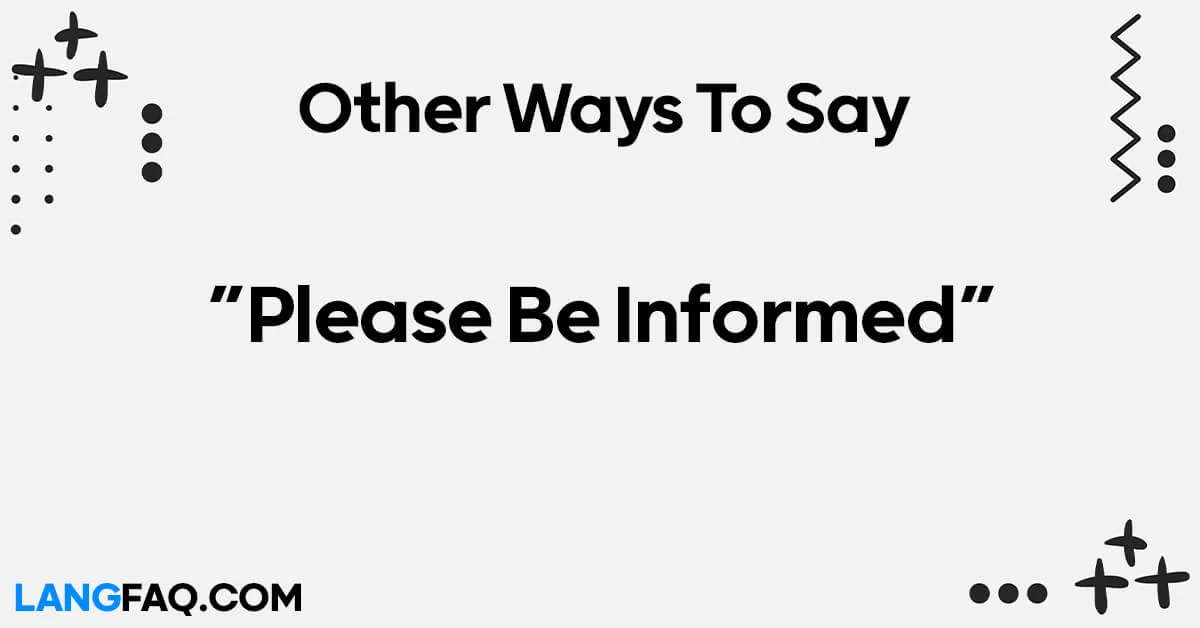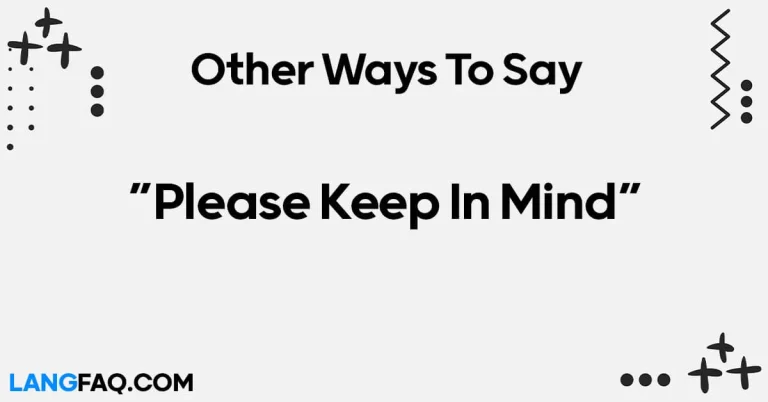Welcome to a linguistic journey where we delve into diverse ways of conveying the phrase “Please Be Informed.” In a world brimming with linguistic richness, discover 12 alternative expressions that not only broaden your vocabulary but also add a touch of sophistication to your communication. Let’s explore each phrase, unraveling its nuances and understanding the contexts in which it shines.
12 Other Ways to Say “Please Be Informed”
Here are 12 alternative ways to say “Please Be Informed”:
- Kindly be advised.
- Allow me to bring to your attention.
- I wanted to make you aware.
- Just a quick heads-up.
- I thought it important to let you know.
- Take note that…
- This is to notify you that…
- It’s worth mentioning that…
- I’d like you to be aware.
- Bringing to your notice.
- Be apprised that…
- I wanted to keep you in the loop.
Here’s a table with meanings and examples for the 12 alternative ways to say “Please Be Informed”:
| Expression | Meaning | Example |
|---|---|---|
| Kindly be advised | A polite way to impart information | Kindly be advised that the meeting is rescheduled. |
| Allow me to bring to your attention | Requesting someone’s focus on important information | Allow me to bring to your attention the new policy changes. |
| I wanted to make you aware | Expressing the intention to share information | I wanted to make you aware of the upcoming event. |
| Just a quick heads-up | Offering a brief and informal alert | Just a quick heads-up, the deadline is approaching. |
| Take note that… | Emphasizing the importance of information | Take note that your account password has been updated. |
| This is to notify you that… | Formally informing someone about a matter | This is to notify you that your application is approved. |
| It’s worth mentioning that… | Highlighting important details | It’s worth mentioning that the project deadline is extended. |
| I’d like you to be aware | Expressing a desire for someone to know | I’d like you to be aware of the safety procedures. |
| Bringing to your notice | Directing attention to specific information | Bringing to your notice the changes in the schedule. |
| Be apprised that… | Notifying someone formally | Be apprised that the company policies are updated. |
| I wanted to keep you in the loop | Keeping someone informed and involved | I wanted to keep you in the loop regarding the project progress. |
| Be conscious of… | Encouraging mindful consideration | Be conscious of the environmental impact. |
These alternative expressions provide a diverse range of ways to convey the notion of “Please Be Informed.” Whether you’re aiming for formality, brevity, or a more casual tone, this array of phrases ensures that you can communicate effectively across various contexts. Incorporate these alternatives into your language repertoire to add nuance and clarity to your communication, enriching your ability to keep others informed in a manner that suits the situation.
Is It Correct to Say “Please Be Informed”?
Yes, “Please Be Informed” is a correct and formal way to notify someone or draw their attention to specific information. This phrase is often used in written communication, such as emails, official letters, or notices, to politely convey important details or updates. It is a clear and direct way to ensure that the recipient is aware of the information being presented.
Example: “Please be informed that the meeting scheduled for tomorrow has been rescheduled to [date and time]. Your presence is highly appreciated.”
In this example, “Please be informed” is used to formally notify the recipient about the change in the meeting schedule. It maintains a polite and professional tone while conveying the necessary information.
Professional Mail Example With “Please Be Informed”
Subject: Important Update – Change in Project Timeline
Dear [Recipient’s Name],
I trust this email finds you well. Please be informed that there has been a necessary adjustment to the project timeline, impacting upcoming milestones.
After careful consideration and in consultation with the project team, we have revised the schedule to ensure the highest quality deliverables. This change is aimed at optimizing our workflow and enhancing overall project efficiency.
Please find the updated timeline attached to this email for your reference. We kindly request your attention to the adjustments made, especially concerning your assigned tasks and deadlines.
Your cooperation in adapting to these changes is highly valued, and we are confident that this modification will contribute positively to the project’s success.
If you have any questions or require further clarification, please do not hesitate to reach out.
Thank you for your understanding and continued dedication to the project.
Best regards,
[Your Full Name] [Your Position] [Your Company] [Your Contact Information]
Kindly Be Advised: Navigating Politeness in Communication
In the realm of professional and formal communication, “Kindly be advised” serves as a courteous alternative to convey important information. This phrase exudes politeness while ensuring that the recipient is made aware of a particular matter. Use this expression when delivering updates, instructions, or any information requiring attention. It’s particularly useful in emails or official notifications.
Scenario:
Imagine you’re an HR manager informing employees about a change in the office timings. In this formal setting, you can utilize “Kindly be advised” to maintain a professional tone.
Example Sentence: “Kindly be advised that starting next week, our office hours will be adjusted to better accommodate team collaboration.”
Email Sample:
Subject: Important Update – Revised Office Hours
Dear [Recipient’s Name],
I hope this message finds you well. Kindly be advised that there will be a change in our office hours effective [Date]. We have carefully considered this adjustment to enhance our team’s productivity and collaboration. Please review the details below:
[Include the revised office hours and any additional relevant information]
We appreciate your understanding and cooperation in adapting to these changes.
Best regards, [Your Name] [Your Position] [Your Company]
Allow Me to Bring to Your Attention: Focused Communication for Impact
“Allow me to bring to your attention” is a sophisticated and formal way to redirect focus to crucial details. This phrase is often employed in professional settings, especially when introducing significant updates, reports, or concerns that require careful consideration.
Scenario:
Picture a scenario where you’re a project manager presenting a quarterly report to stakeholders. Use “Allow me to bring to your attention” to underscore key points and data.
Example Sentence: “Allow me to bring to your attention the remarkable growth in our market share, which is a testament to our team’s dedication and strategic initiatives.”
Email Sample:
Subject: Quarterly Report Highlights – Key Achievements
Dear [Recipient’s Name],
I trust this email finds you well. Allow me to bring to your attention the notable achievements highlighted in our recently concluded quarter. The team’s collective efforts have resulted in significant advancements, and I am pleased to share the key highlights below:
[Include detailed achievements, statistics, and relevant data]
Your ongoing support and guidance are invaluable to our continued success.
Best regards, [Your Name] [Your Position] [Your Company]
I Wanted to Make You Aware: A Gentle Approach to Sharing Information
When adopting a more personal and empathetic tone, “I wanted to make you aware” conveys the speaker’s intention to share information in a considerate manner. This expression is versatile and can be used in both professional and informal contexts.
Scenario:
Imagine you’re a team lead addressing a concern within the team. “I wanted to make you aware” allows you to approach the situation with empathy while ensuring transparency.
Example Sentence: “As your team lead, I wanted to make you aware of the recent feedback we received from clients, emphasizing the areas where we can enhance our service.”
Email Sample:
Subject: Important Feedback – Opportunities for Improvement
Dear [Team Member’s Name],
I hope this message finds you well. I wanted to make you aware of the constructive feedback we received from our clients during the recent project. Your dedication is commendable, and I believe addressing these areas will contribute to our collective growth.
[Include specific feedback points and suggestions for improvement]
Thank you for your ongoing commitment to excellence.
Warm regards, [Your Name] [Your Position] [Your Company]
Just a Quick Heads-Up: Informal and Concise Notices
For a more casual and friendly tone, “Just a quick heads-up” is an excellent choice. This expression is perfect for brief notifications or updates where a less formal approach is appropriate. It’s commonly used among colleagues or friends to share important but not overly formal information.
Scenario:
Imagine you’re part of a project team and need to inform your colleagues about a minor adjustment in the project timeline. Use “Just a quick heads-up” to maintain a friendly atmosphere.
Example Sentence: “Hey team, just a quick heads-up that we’ve pushed the deadline for the project by a day to ensure top-notch quality.”
Email Sample:
Subject: Project Update – Revised Deadline
Hi Team,
Just a quick heads-up – we’ve made a slight adjustment to the project timeline. The new deadline is now [Date]. This tweak will allow us to deliver a stellar final product.
Thanks for your flexibility and dedication to excellence.
Cheers, [Your Name] [Your Position] [Your Company]
Take Note That…: Emphasizing Importance and Urgency
When precision and urgency are paramount, “Take note that…” serves as a direct and assertive way to communicate essential information. This phrase is particularly useful in situations where immediate attention is required.
Scenario:
Imagine you’re a manager communicating a critical policy update that necessitates swift action. “Take note that…” conveys the urgency of the matter.
Example Sentence: “Take note that starting next month, the new security protocols will be in effect. Please review the attached document for details.”
Email Sample:
Subject: Urgent – Implementation of New Security Protocols
Dear [Recipient’s Name],
I trust this message finds you well. Take note that, effective [Date], our company will be implementing new security protocols to enhance data protection. It is imperative that all employees adhere to these guidelines.
[Attach the detailed document outlining the new security protocols]
Your cooperation in ensuring a smooth transition is greatly appreciated.
Best regards, [Your Name] [Your Position] [Your Company]
This Is to Notify You That…: Formal Announcements and Notifications
For official announcements or notifications, “This is to notify you that…” adds a touch of formality, making it clear that the information being conveyed is of significant importance. This phrase is suitable for professional communications and official notices.
Scenario:
Imagine you’re a legal advisor informing a client about a change in contractual terms. “This is to notify you that…” establishes a formal tone for such crucial matters.
Example Sentence: “This is to notify you that, pursuant to clause [X] of the contract, there will be amendments in the payment schedule effective [Date].”
Email Sample:
Subject: Official Notification – Amendment to Payment Schedule
Dear [Client’s Name],
I hope this message finds you well. This is to notify you that, in accordance with the contractual agreement, there will be amendments to the payment schedule outlined in clause [X].
[Include details of the amended payment schedule and any necessary information]
Thank you for your attention to this matter.
Sincerely, [Your Name] [Your Position] [Your Company]
It’s Worth Mentioning That…: Highlighting Key Details with Precision
When you want to draw attention to specific information without unnecessary formality, “It’s worth mentioning that…” is an ideal choice. This expression allows you to emphasize noteworthy details in a clear and straightforward manner.
Scenario:
Imagine you’re a team leader providing feedback on a project update. Use “It’s worth mentioning that…” to underscore crucial aspects without overwhelming your team.
Example Sentence: “It’s worth mentioning that the client was particularly impressed with the innovative approach we took in the latest project presentation.”
Email Sample:
Subject: Client Feedback – Commendations for Project Presentation
Dear Team,
I trust you are all well. It’s worth mentioning that our client expressed high praise for the innovative approach showcased in our latest project presentation. Your dedication and creativity truly stood out.
Keep up the excellent work!
Best regards, [Your Name] [Your Position] [Your Company]
I’d Like You to Be Aware: A Gentle Prompt for Understanding
In situations where you want to ensure that someone is informed without sounding authoritative, “I’d like you to be aware” is a considerate choice. This phrase implies a request for understanding rather than a strict directive.
Scenario:
Imagine you’re a mentor guiding a mentee through a learning process. “I’d like you to be aware” sets a supportive tone for sharing insights.
Example Sentence: “As your mentor, I’d like you to be aware that constructive feedback is an integral part of your growth journey. Embrace it as a catalyst for improvement.”
Email Sample:
Subject: Mentorship Insight – Embracing Constructive Feedback
Dear [Mentee’s Name],
I trust this email finds you well. As we navigate your growth journey together, I’d like you to be aware that constructive feedback is a powerful tool for your development. Embrace it with an open mind, as it serves as a catalyst for continuous improvement.
Looking forward to seeing your progress.
Warm regards, [Your Name] [Your Position] [Your Company]
Bringing to Your Notice: Ensuring Clarity in Communication
“Bringing to your notice” is a versatile phrase that bridges formality and directness. Use this expression when you want to make sure the recipient is fully informed about a particular matter. It’s suitable for various contexts, from professional communications to more informal settings.
Scenario:
Imagine you’re a project manager updating your team about a change in project scope. “Bringing to your notice” ensures that everyone is aware of the modification.
Example Sentence: “Bringing to your notice the adjustment in the project scope, which aligns with the client’s evolving requirements.”
Email Sample:
Subject: Important Update – Modification in Project Scope
Dear Team,
I hope this message finds you in good spirits. Bringing to your notice an important update regarding the project scope. The following adjustments have been made to align with the evolving requirements of our client.
[Include details of the modified project scope]
Your cooperation in adapting to these changes is highly appreciated.
Best regards, [Your Name] [Your Position] [Your Company]
Be Apprised That…: Formal Notifications with Authority
When conveying information with a sense of authority and formality, “Be apprised that…” is an excellent choice. This phrase indicates a formal notification, ensuring that the recipient is informed with a touch of gravitas.
Scenario:
Imagine you’re a legal advisor communicating changes in contractual obligations to a client. “Be apprised that…” adds a layer of formality to the communication.
Example Sentence: “Be apprised that, as per the revised terms in the contract, there will be adjustments in the delivery timeline.”
Email Sample:
Subject: Official Notification – Contractual Adjustments
Dear [Client’s Name],
I trust this message finds you well. Be apprised that, in accordance with the revised terms outlined in our contract, there will be adjustments to the delivery timeline.
[Include detailed information about the adjusted delivery timeline]
Your understanding and cooperation are appreciated.
Sincerely, [Your Name] [Your Position] [Your Company]
I Wanted to Keep You in the Loop: Fostering Open Communication
For a more casual and inclusive tone, “I wanted to keep you in the loop” is an expression that conveys transparency and openness. Use this phrase when sharing updates, information, or decisions that involve others and when you want to foster a sense of collaboration.
Scenario:
Imagine you’re a team lead updating your colleagues about a project development. “I wanted to keep you in the loop” creates an atmosphere of shared information.
Example Sentence: “I wanted to keep you in the loop about the exciting new developments in the project, showcasing the collective effort of our team.”
Email Sample:
Subject: Project Update – Keeping You in the Loop
Hi Team,
I hope this email finds you well. I wanted to keep you in the loop about some exciting developments in our ongoing project. Your collective efforts have led to significant progress, and I’m thrilled to share the details below:
[Include specific details about the project developments]
Thank you for your dedication and contributions.
Best regards, [Your Name] [Your Position] [Your Company]
Be Conscious Of: Encouraging Mindful Consideration
“Be conscious of” is a phrase that prompts thoughtful consideration. It suggests an awareness that goes beyond mere acknowledgment, urging individuals to approach a situation with mindfulness. This expression can be used in various contexts, from personal advice to professional guidance.
Scenario:
Imagine you’re a wellness coach advising someone on stress management. “Be conscious of” encourages mindful consideration in approaching stressors.
Example Sentence: “As you navigate stressful situations, be conscious of your reactions, and take proactive steps towards maintaining your well-being.”
Email Sample:
Subject: Wellness Tips – Being Conscious of Stress Management
Dear [Recipient’s Name],
I hope this message finds you in good health. In your journey towards well-being, I encourage you to be conscious of how you respond to stressors. Consider the following tips for effective stress management:
[Include practical tips for stress management]
Wishing you continued health and resilience.
Warm regards, [Your Name] [Your Position] [Your Company]
FAQs
Q: Are these phrases suitable for formal communication? Absolutely! The provided phrases offer a range of formality, ensuring there’s an option for every context, from casual conversations to professional settings.
Q: Can I use these alternatives in written communication? Certainly! These expressions are versatile and can be seamlessly integrated into both verbal and written forms of communication.
Q: Are there cultural considerations for using these phrases? While most of these phrases are universally applicable, it’s advisable to be mindful of cultural nuances. Ensure the chosen expression aligns with the cultural context of your audience.
Q: Which phrase is best for urgent communication? “Take Note” and “Receive the Update” are excellent choices for urgent communication, conveying a sense of immediacy.
Q: How can I remember to use these alternatives in daily conversations? Practice incorporating these phrases into your everyday communication. Soon, they’ll become second nature, enriching your language repertoire.
Q: Are there situations where the standard phrase is more appropriate? In highly formal or legal contexts, sticking to the standard “Please Be Informed” might be more suitable to maintain precision and clarity.
Conclusion:
In this linguistic exploration, we’ve uncovered 12 vibrant ways to convey the message “Please Be Informed.” From formal to casual, these expressions cater to diverse communication needs. Embrace linguistic diversity, and let your words resonate with impact.







